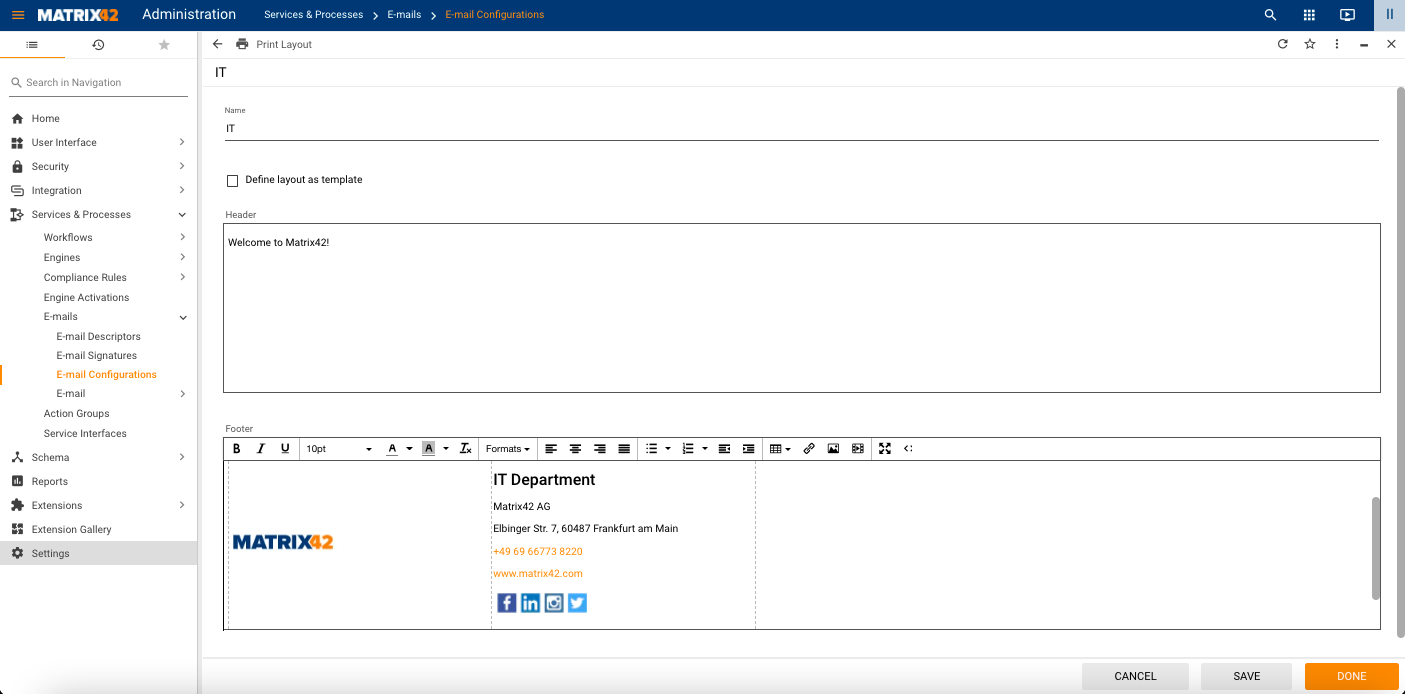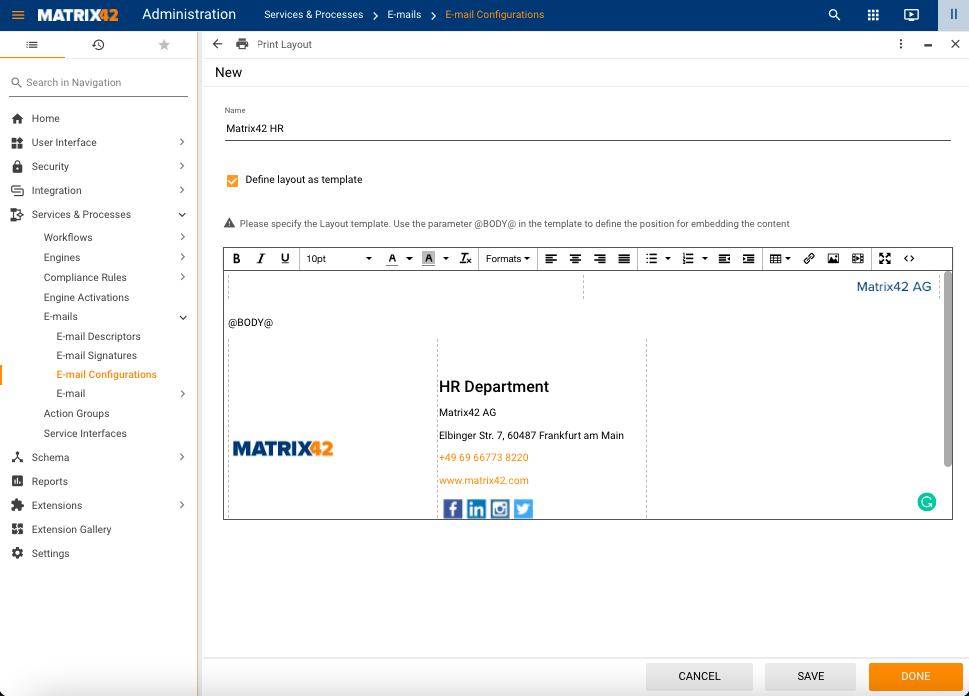E-mail Configurations
Overview
E-mail Configurations area allows dynamically changing some attributes of the e-mail based on the configurable data for the e-mails, therefore each department of the organization can have a personalized e-mail style, sender, signature, header, and footer:
Prerequisites
- ESMP v.11.0.1 or higher
E-mail Configurations
E-mail Configurations are available in the Administration application → Services & Processes → E-mails → E-mail Configurations:

The page shows configured profiles for your e-mails, including the following information:
- Name: internally used name of the E-mail Configuration.
- Sender e-mail: allows defining a specific e-mail address for the Organization Unit or department and further simplify the e-mail processing, unlike the case when all outgoing e-mails from the system have the same sender.
- Organization Unit: assigned Organization Unit. For more details, see also Managing organizational units page.
- Template: shows if the Template is used in the E-mail Configuration. The template is designed to add a header and footer to the e-mail.
- Signature: shows if the E-mail Configuration has an e-mail signature. See also E-mail Signatures page.
Configuration
On the E-mail Configurations page, click +Add E-mail Configuration action and fill out the following fields:

E-mail Configuration is designed to dynamically design e-mails and not all fields of the configuration are mandatory. Configuration can be based on at least one of the configurable properties (Sender, Organization Unit, Template, Signature, Organization Unit, Role) or their combinations.
- Name: internally used name of the E-mail Configuration.
- Template: defines the layout of the e-mail
- Name: internally used name of the Template.
- Define layout as template checkbox depending on the mode provides the following configurable options:
- not selected (default): use the suggested editor to create the Header and the Footer for the E-mail Configuration:

- selected: please specify the Layout template in the suggested area of the editor, which can include the header and footer. Use the parameter @BODY@ in the template to define the position for embedding the content, for instance:

- not selected (default): use the suggested editor to create the Header and the Footer for the E-mail Configuration:
- Signature: includes the information that is placed at the bottom of each e-mail, after the body of the e-mail. Choose from the available in the system signatures. See also E-mail Signatures page.
- Skin: optionally, select the e-mail descriptor design. See also E-mail Skins page.
- Sender e-mail: assigned e-mail address. The property is optional and even if not set the sender's address is assigned according to the priorities, as described below.
- Description: optional description of the configuration.
- Organization Unit: assigned Organization Unit, which is one of the criteria for dynamic selection of e-mail configuration based on the selected attribute. See also Managing organizational units page.
- Role: assigned user Role. See also Security Management: User Roles and Permissions.
The E-mail Configuration displays the e-mail content in the following order:
- Header
- Body (defined by the corresponding E-mail Descriptor)
- Signature
- Footer
Usage
E-mail Descriptors
Created E-mail Configuration can be assigned to an E-mail Descriptor.
In the Administration application, open Services & Processes → E-mails → E-mail Descriptor → choose the item and click Edit action.
- Do not use E-mail Configuration: by default, all E-mail Descriptors do not use E-mail Configuration.
- Select E-mail Configuration: to use the static E-mail Configuration, choose the Select E-mail Configuration option and assign an E-mail Configuration as suggested in the example below.

- Use Expression to specify E-mail Configuration: enter an ASQL expression to dynamically apply the necessary E-mail Configuration. Please define filter expression for "E-mail Configuration" Data Definition (SVMEmailConfigurationClassBase). Use available E-mail Descriptor parameters in the expression, e.g. @param_name.
In this case, the corresponding E-mail Configuration is applied dynamically according to the configured in it parameters (among them are all the configurable properties in the E-mail Configurations and user role) and based on the input parameters of the E-mail Descriptor.
For instance, to search for and apply an E-mail Configuration for an Order depending on Recipients department (Organization Unit) use he following query in the E-mail Descriptor:
EXISTS(SUBQUERY(SPSSelfServiceOrderItemClassBase AS A, A.ID, A.[Expression-ObjectID] = @SPSSelfServiceOrderItemType AND base.OU = A.RequestFor.T(SPSCommonClassBase).OU))
To search for and apply an E-mail Configuration for a ticket that has an assigned user role use the following query in the E-mail Descriptor:
EXISTS(SUBQUERY(SPSActivityClassBase AS A, A.ID, A.ID = @SPSActivityClassBase AND base.Role = A.RecipientRole.T(SPSSecurityClassRole).ID))

Click Done to apply changes.
An E-mail Descriptor with E-mail Configuration has the following structure:
- Header
- Body (defined by the corresponding E-mail Descriptor)
- Signature
- Footer

Global System Settings
Global System Settings allow defining the default E-mail Configuration.
In the Administration area, open Settings → Edit → E-mails view → Header/Footer field and choose from the available in the system options.
Priorities
Several components of the E-mail Configurations can be assigned from different areas of the application, therefore in order to avoid interceptions, the following rules and priorities were introduced.
E-mail from or Sender:
- E-mail Configurations: if the E-mail Descriptor has assigned E-mail Configuration, the e-mail sender's address will be taken from the E-mail Configuration (see Sender e-mail property) ;
- Global System Settings: if the E-mail Configuration for the E-mail Descriptor does not contain Sender e-mail or is not specified, the system uses the Default Sender value. See also, Global System Settings:E-mails section.
- Default Server settings: if the e-mailing is configured but no address is specified either in Sender e-mail of the E-mail Descriptor's E-mail Configuration or in the Default Sender of the Global System Settings, the system uses the e-mail address from the default e-mailing server settings.
These rules are applied when sending e-mails with Send e-mail action, for instance from the E-mail Descriptor:
